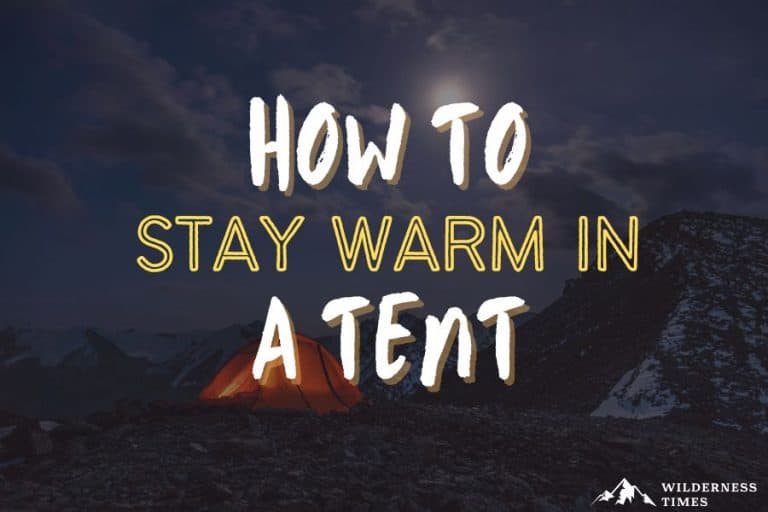Have you ever slept in nature and froze to your bones?
Awful feeling, I know.
You might want to go camping again, but are afraid that your experience will be the same.
Don’t worry! I got you covered.
In this article, you’ll learn all about how to stay warm in a tent – even in the coldest temperatures!
Ready?
Let’s warm up our minds with the tips below!
Table of Contents
Toggle11 Tips & Tricks For Staying Warm In A Tent
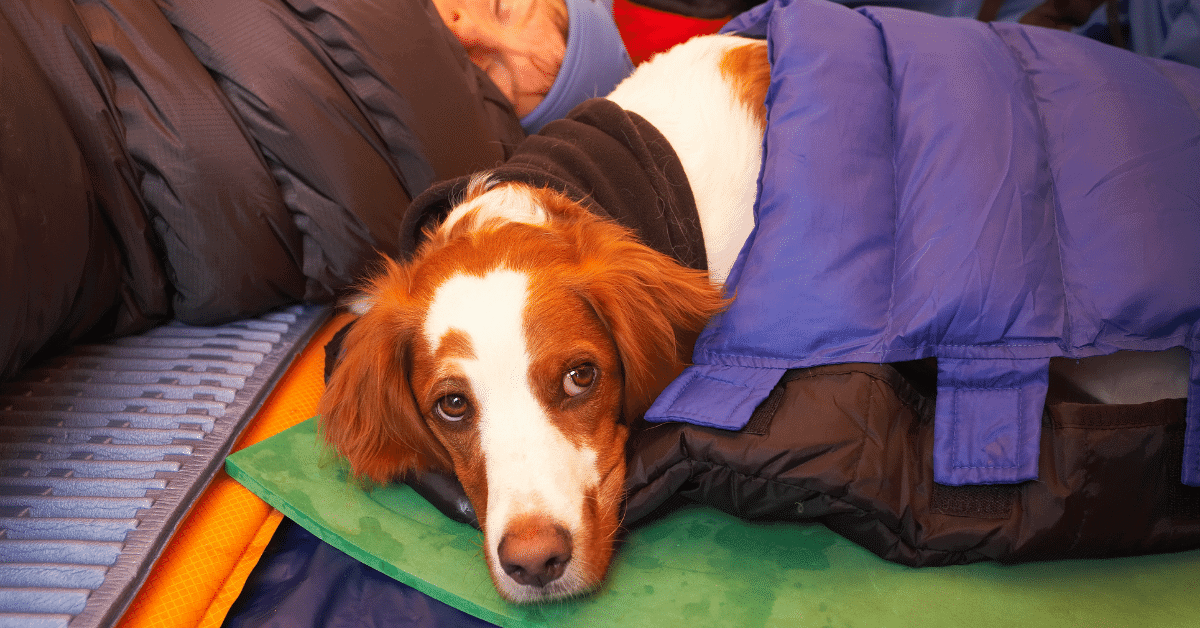
Preparation and packing are half of the work you need to do to feel warm on your adventure.
Sure, extra blankets will help, but there are other things you might not think of that can warm you up.
Read the tips I’ve written below to find out what can keep you warm even on the coldest days.
Check The Weather Before You Head Out
A few days before you head out on your adventure, become a weather forecast master.
Check what the weather is going to be like in the area where you plan to camp.
I suggest checking on different websites to get more accurate info.
Pick Your Campsite
You’ll want to avoid low lying areas such as valleys, and you should also avoid peaks.
Here’s why: Cold air sinks, whereas hot air rises.
The ground in a valley can feel like you’re sleeping on ice.
At the same time, camping at the highest points leaves you more exposed to windy and dangerous weather conditions.
So, choose a campsite on a mid-elevation point.
It’s even better if you find a spot that is naturally protected from the wind. If you can’t find a natural windbreak, you can always build one yourself.
Prepare Your Campsite
If you haven’t got a windbreak, you should add a tarp or wind cover to your tent.
This will help by keeping the wind out and reducing the amount of heat that the wind sucks out of your tent as it blows by.
If you plan to camp in a snowy area, you should clear away any snow before pitching your tent. If you’re unable to clear the snow completely, at the very least, you should be able to create a level surface.
If necessary, smooth out the tent floor to further clear the snow away from your sleeping area. Just make sure you do it right away. If you wait, the snow may melt and reform as ice beneath you.
Tent Insulation
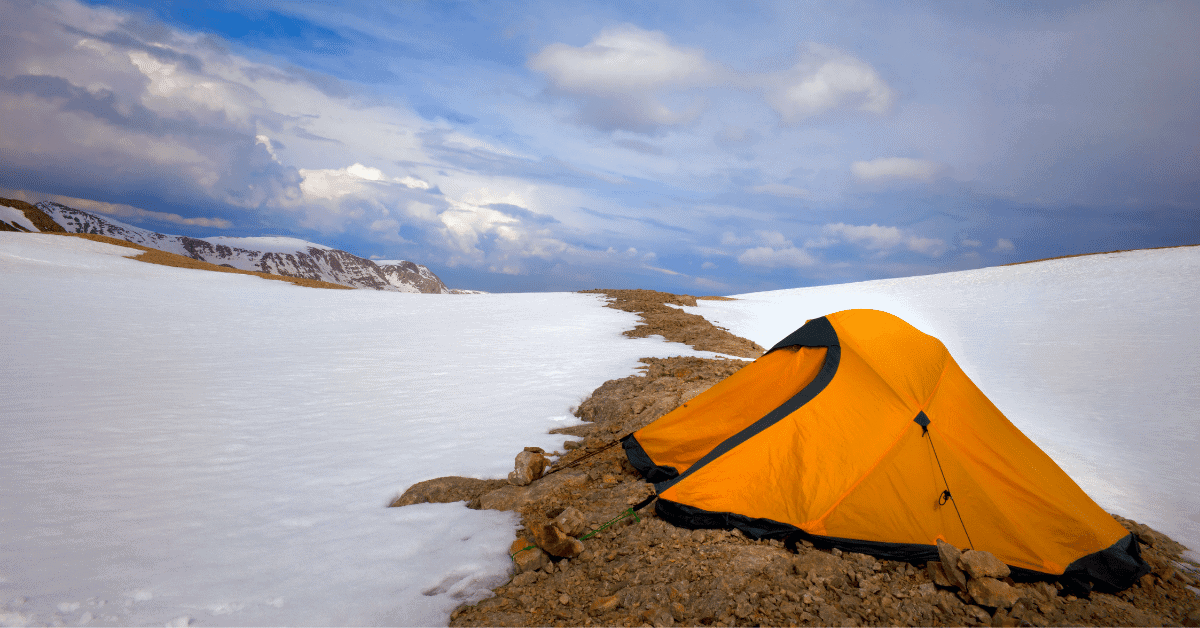
The heat from your body can be sucked out by cold ground. First of all, you should camp in a weatherproof, insulated tent.
When choosing a tent, opt for a three or four-season model. A three-season tent is a good option if you plan to camp in the late spring, summer, or early fall. A four-season model is recommended if you plan to camp in the late fall, winter, and early spring.
A good sleeping pad is something you should definitely have. However, there will be times when you will require a little more insulation. By putting an exercise mat underneath your sleeping pad, you can improve heat retention in your tent.
You can also make use of your surroundings! Gather leaves and pine branches to make a layer in your tent that resembles a natural rug, and place your sleeping pad on top.
Read: How To Insulate A Tent For Winter Camping & Tips To Stay Warm In Nature
Sleeping Bag Alert
Your bedding is your most effective way to feel warm in a tent. Make sure to choose a weather appropriate sleeping bag.
Here’s the deal: for the best results, use a sleeping bag designed for colder weather than you expect it to be.
A 0-degree sleeping bag will benefit you greatly when camping on a long cold night.
It’s also a good idea to use a sleeping bag liner, as this will keep you even warmer and increase the effectiveness of your sleeping bag.
Different materials will provide different degrees of warmth, so look for winter materials like fleece if you want to be super cozy.
Another trick that you can do to make sure you stay over the night is to fill up your sleeping bag.
Let me explain: any extra space inside the sleeping bag is filled with air. Between your body heat and the sides of the sleeping bag, the air quickly cools down.
That’s why a mummy bag keeps you warmer than a rectangular sleeping bag – there’s less empty space.
But there is a solution to this problem.
It’s to leave as little space as possible in your sleeping bag.
Put blankets inside your bag as this will keep you warmer than piling them on top of you. Any blanket will do, but obviously blankets made of wool or fleece are the warmest option.
If you don’t have blankets with you, fill your bag with clothes you are not wearing.
This is a win win option. Because it will not only keep you warm during the night, but it will also keep your clothes warm for when you want to wear them the next day.
Dress Up From Head To Toe!
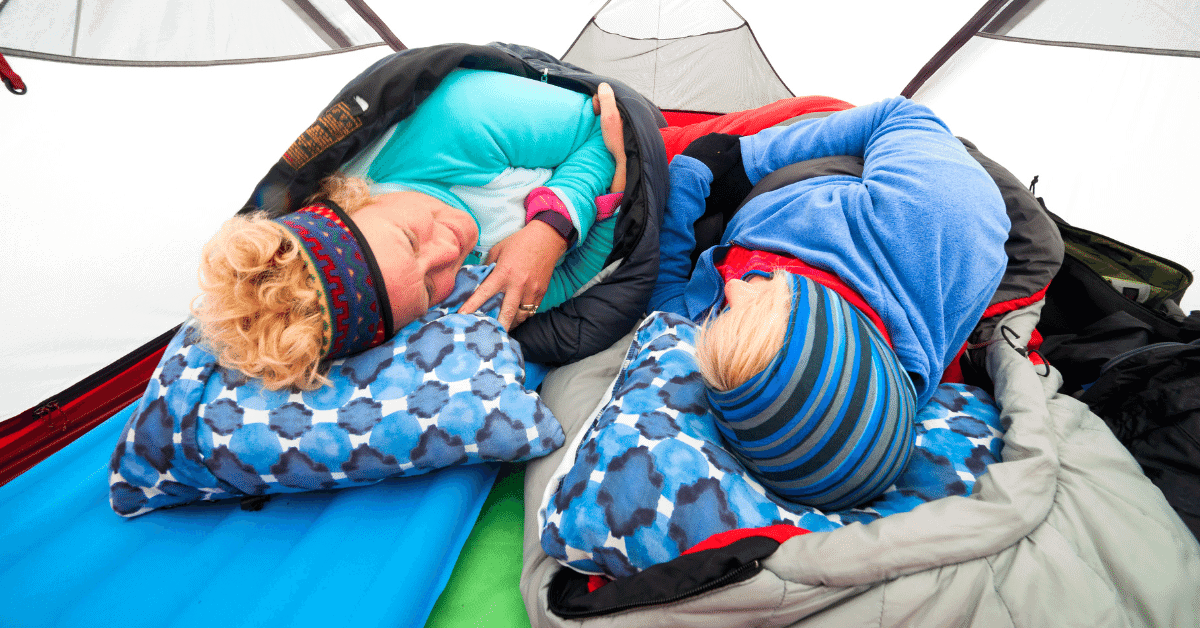
Your sleeping bag is probably the most important thing that’ll help you feel warm at night. That being said, warm clothes and layers are also super important when it comes to protecting your body from the cold.
I’d recommend wearing a good pair of long johns underneath your regular sleeping clothes.
If you feel warm during the night you can easily remove a layer and continue sleeping. But if you freeze due to not wearing enough layers, it will be more difficult for you to warm up.
But here’s the kicker:
Most of our body’s heat escapes through the bottoms of our feet and the top of our head. So to be extra sure you’ll stay warm, keep your head and feet covered and dry.
Do not sleep in your hiking socks. Sweaty socks will ruin your good night’s sleep.
To be sure you’ll have an extra pair of dry socks, you can pack a pair in the bottom of your sleeping bag, before heading out on your adventure. When you’re setting in for the night in your dry warm socks, you’ll be grateful to yourself for preparing them earlier.
Obviously, you can keep your head warm by wearing a winter hat, or if you feel creative, you can use your scarf to create a turban.
You can even put on gloves. This will keep you warm if you have to get up in the middle of the night when nature calls. Or if you just want to push your arm out during the night.
Eat Like A Bear & Hydrate Yourself
Your body may need as many as 6,000 calories per day when hiking in cold temperatures.
This basically means that you can eat guilt-free high-calorie meals. Hurray!
Keep in mind that your meals should be high in fat. Good news for those on a keto diet.
Here are some foods that are healthy, easy to carry with you, and rich in fat:
- Avocados
- Dark chocolate
- Nuts
- Chia seeds
- Olives
Why do you need to eat foods high in fat? – I hear you asking.
Good question.
Here’s the gist of it.
When compared to protein or carbohydrates, fat has more than twice the calories per gram. Calories are a type of heat unit. More calories equal more heat.
Eating a meal before going to bed will keep your stomach busy during the night. The act of digesting itself will help your body to warm up.
Make sure to stay hydrated throughout the day. However, don’t drink too many liquids right before you tuck in.
To warm up your body before going to bed, I recommend drinking a cup of tea. Then, go get all the liquids that want to get out, out of your system before hitting the hay.
You are now ready to go to bed, warmed up and emptied, with a low chance of needing to go during the night.
Use An Insulated Bottle As A Hot Water Bottle
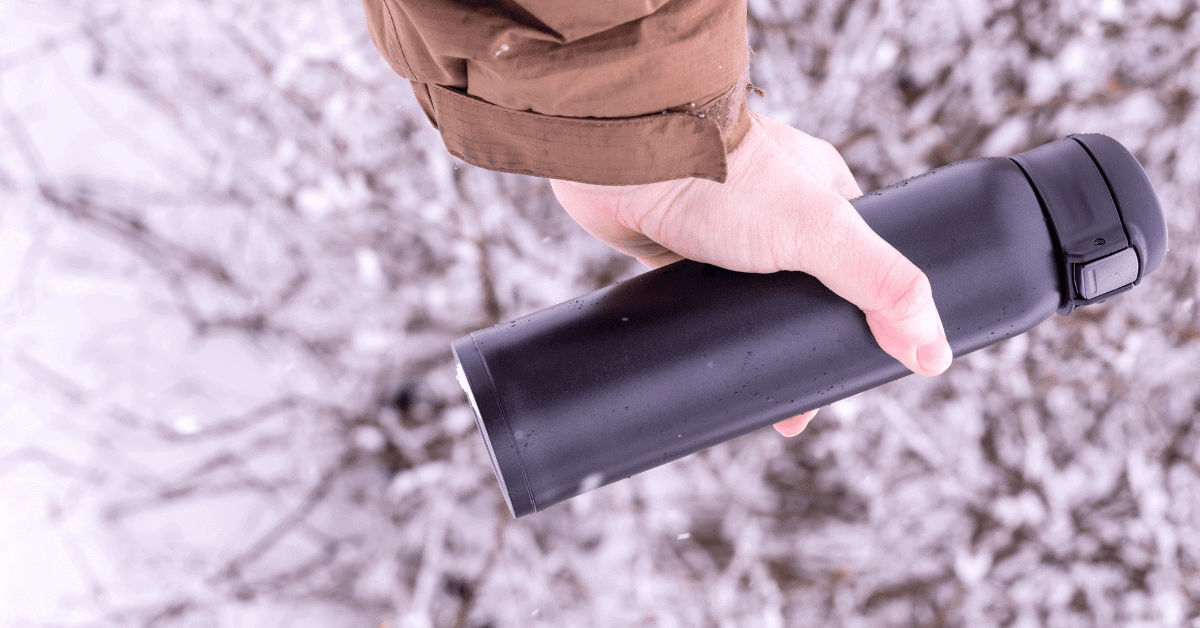
Another great hack to keep you warm is to bring an insulated water bottle with you.
While you are preparing your good night tea, boil some extra water for your bottle on your camping stove or campfire.
Get this:
If you are in a snowy or icy area, you don’t even need to use your drinking water!
You can put the snow or ice on your camping stove to make hot water.
Once your water is ready, fill your bottle and put it inside your sleeping bag. If you have more than one hot water bottle, even better.
You can put the bottle(s) near your feet or close to your belly or inner thighs. When these spots heat up, they’ll keep your body warm for hours.
So, when going on an adventure in the cold be sure to invest in a bottle that’ll hold the temperature for a longer period.
Throughout the day they’ll keep you hydrated and through the night they can work as portable heaters! Win win!
Use A Tent Heater
Speaking of portable heaters… one sure fire way to make the space inside your tent warmer is by using a tent heater.
You can go for either a gas heater or an electric heater. Both will perform well and keep you toasty warm inside your tent. That said, they do each have their pros and cons.
Electric heaters require a power source, but you don’t run the risk of carbon monoxide poisoning, which is something you need to be very careful of when using a gas heater.
For that reason, I prefer an electric heater in most cases, except for when I’m camping in the wild where I don’t have anywhere to plug one in.
Also see: Is a Mr. Heater Buddy Safe in a Tent?
Fill Your Tent
Another formula to warm up – and this is maybe the most heartwarming one – is to fill up your tent!
When camping in cold weather it is better not to use a massive tent. Big tents have a lot of space, which means a lot of air will get inside, which will obviously make it harder to warm the space up.
If you are traveling alone, definitely go for the smallest tent you can find. A good bivy tent is your best bet at staying warm at night.
If you are traveling with others, don’t spread out in different tents. Instead, scooch up in one tent!
If you are camping with your loved one, snuggle up in one sleeping bag. Be sure to invest in zip-together sleeping bags or extra-large bags designed for two people.
Furry friends can also make an awesome sleeping buddy. Just make sure that they are comfortable in a tent. Give it some time, though. Some dogs won’t like it at first, but will warm up to it eventually.
I usually go camping with my dog and it feels amazing and super warm when she snuggles her back to mine. Not only does it feel warm on the outside, but the warmth of my heart also heats my body from the inside!
Go To Bed Warm

I mentioned before that it’s a good idea to drink a cup of tea and go to the toilet before you go to bed.
But also, right before you tuck in, you can do a few jumping jacks or burpees to get your blood flowing. Be sure to do just enough to warm up, not to get sweaty.
Want to know the best part?
You can warm up by exercising in your sleeping bag. Just do a few crunches if the cold is starting to get to you.
Remember to layer up before you turn in for the night. If you feel too warm, just take a layer off. Easy peasy!
Store Your Clothes Properly
You might be wondering what to do with tomorrow’s clothes for them to feel soft and warm.
Well, as I mentioned, if they are dry, put them in your sleeping bag with you.
They will add an extra layer of insulation. Plus, in the morning when you’re getting ready, you’ll be happy to put on dry warm clothes.
If your clothes for tomorrow are damp or wet, don’t ball them up in a corner. This will make them retain moisture and possibly freeze up.
Instead, spread them out on the floor of your tent or, if possible, hang them up.
If you make a campfire at night, you can put them around it for some extra drying.
And, one last piece of advice to keep in mind:
In the morning after your beautiful warm sleep, spread out your sleeping bag to dry from any moisture. You don’t want to spend your second night in a chilly sleeping bag.
Let’s Wrap It Up
OK, so reading all the info we’ve covered here might have been enough to warm up your head. But, now it’s time to put what you’ve learned into practice and warm up your body.
- So, make sure you check the weather daily and prepare accordingly for your camping trip.
- Choose and prepare your campsite wisely.
- Insulate your tent from the inside with sleeping pads, blankets, or with nature itself.
- Investing in a warm sleeping bag is a must!
- Layer up with warm comfy clothes.
- Eat and drink as much as you like on your trip guilt-free. The cold will burn the extra calories.
- Bring an insulated bottle or bottles with you!
- Fill your tent with loved ones! Humans or dogs, I wouldn’t suggest hosting a bear inside for a slumber party. Maybe a cute fox though.
- Warm-up before bed with a nice cup of tea and a bit of aerobics.
- Store your clothes and sleeping bag well so they can serve you throughout your trip.
Voila! You’re ready to camp anywhere in the world, even in Antarctica!


